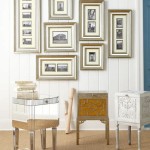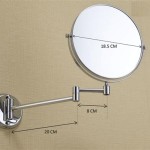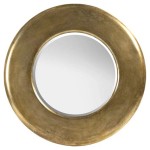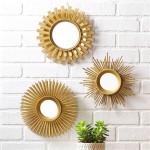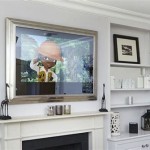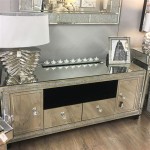```html
Black Victorian Style Mirrors: A Glimpse into Elegance and History
Black Victorian style mirrors represent a captivating blend of functionality and ornate design, reflecting the aesthetic sensibilities of the Victorian era (roughly 1837 to 1901) infused with a dramatic, contemporary twist. These mirrors are characterized by their dark, often black, frames which serve to accentuate the intricate details and craftsmanship typical of the period. The popularity of black finishes, while not necessarily ubiquitous in original Victorian interiors, adds a level of sophistication and depth that resonates with modern design preferences. This article explores the characteristics, historical context, and modern applications of black Victorian style mirrors.
Key Features of Black Victorian Style Mirrors
The defining feature of a black Victorian style mirror is, of course, its frame. These frames are typically made of wood, often hardwoods such as mahogany, walnut, or oak, which are then stained or painted black. The black finish can range from a matte, chalky black to a highly polished, almost reflective black, depending on the desired aesthetic. The frame itself is usually highly ornamented, with a profusion of carved details. These details often include floral motifs, scrolling patterns, geometric designs, and sometimes even figural representations.
Another critical element is the shape. Victorian mirrors often feature elaborate and unconventional shapes. Ovals, arched tops, and frames with multiple curves are common. Some mirrors may even incorporate small shelves or drawers into the design, offering a blend of functionality and visual interest. The size of the mirror can vary greatly, from small, handheld vanity mirrors to large, statement pieces designed to dominate a room.
The glass itself, while often less emphasized than the frame, is also important. Antique Victorian mirrors may feature imperfections in the glass, adding to their character and charm. Modern reproductions typically use higher-quality glass, offering a clearer and more accurate reflection, but some manufacturers intentionally distress the glass to mimic the appearance of age. The glass may also be beveled, adding another layer of visual complexity and refinement.
Historical Context and Influences
The Victorian era was a period of significant industrial and social change, and these changes profoundly influenced design trends. The rise of the middle class and increased industrial production made decorative items more accessible. This led to a desire for ornate and elaborate furnishings that signified wealth and status. Victorian interiors were often characterized by a sense of abundance and layering, with rooms filled with furniture, textiles, and decorative objects.
The aesthetic of Victorian design was influenced by a variety of sources, including Gothic Revival, Rococo Revival, and Aestheticism. Gothic Revival brought back elements of medieval architecture, such as pointed arches and quatrefoil motifs. Rococo Revival emphasized curves, asymmetry, and floral ornamentation. Aestheticism, on the other hand, promoted the idea of "art for art's sake" and focused on beauty and craftsmanship, often incorporating elements from Japanese and other non-Western cultures.
While black finishes were not as universally prevalent as darker woods like walnut or mahogany in original Victorian interiors, they did appear in certain contexts. Black could have implied mourning within the period, or was sometimes used for ebonized furniture, which imitated the look of expensive ebony wood. The combination of black frame with the ornate detailing of Victorian design evokes a sense of drama and formality, adding a bold contrast to the often elaborately decorated interiors of the time.
The black Victorian style mirror, as it is understood today, often incorporates more modern sensibilities. The use of black paint or stain can be seen as a way to update a classic design, making it more compatible with contemporary color palettes and decorating schemes. It also draws attention to the intricate detailing of the frame, highlighting the craftsmanship involved in its creation.
Modern Applications and Decorating Ideas
Black Victorian style mirrors are versatile decorative elements that can be incorporated into a wide range of interior design styles. They can serve as statement pieces in living rooms, bedrooms, hallways, or even bathrooms.
In a modern minimalist setting, a black Victorian mirror can provide a striking contrast to the clean lines and neutral colors. The ornate frame adds visual interest and texture, preventing the space from feeling sterile or impersonal. The dark color of the frame also anchors the mirror, grounding it in the space.
In a maximalist or eclectic setting, a black Victorian mirror can complement the existing layers of patterns, colors, and textures. The mirror can be incorporated into a gallery wall, adding depth and dimension to the display. Its dark frame provides a sense of cohesion and visual balance amidst the diverse array of elements.
In a bedroom, a black Victorian mirror can be used as a vanity mirror or as a decorative element above a dresser. It adds a touch of glamour and sophistication to the space, creating a luxurious and inviting atmosphere. The mirror can be paired with other vintage or antique pieces to create a cohesive and historically inspired look.
In a bathroom, a black Victorian mirror can add a touch of elegance and drama. The dark color of the frame provides a striking contrast to the white or pastel-colored walls and fixtures typically found in bathrooms. Choose a mirror that is specifically designed for use in humid environments to prevent damage to the frame.
When choosing a black Victorian style mirror, consider the size, shape, and detailing of the frame. The size of the mirror should be proportionate to the space in which it will be placed. The shape of the mirror should complement the other architectural features and furniture in the room. The detailing of the frame should reflect the overall style and aesthetic of the space.
The placement of the mirror is also important. Consider the light sources in the room and position the mirror to maximize the reflection of light. This can help to brighten the space and create a sense of spaciousness. Also, think about what the mirror will reflect. A strategically placed mirror can enhance the views from windows or highlight interesting architectural details.
Ultimately, the appeal of black Victorian style mirrors lies in their capacity to blend historical charm with contemporary design sensibilities. They serve as conversation starters, adding a touch of dramatic elegance and a hint of the past to modern living spaces. Their inherent versatility allows them to seamlessly integrate into varied decorating schemes, making them a timeless and impactful addition to any interior.
```
Black Victorian Style Emele Mirror

Moda Victorian Black Wall Mirror Gothic Home Decor Blue Walls White

Ormolu Highlife Mirror Living Room Mirrors Ornate Vintage Style

Dark Victorian Wall Mirror Gothic Style Home Decor Baroque

French Style Black Mirror

Large Black Victorian Style Overmantle Mirror Kernow Furniture

Deco Mirror 22 In W X 38 H Vintage Arch Black Ornate Metal Framed Accent Wall 384445web The Home Depot

Gothic Victorian Coffin Mirror
Huge Antique Style Black And Silver Victorian Revival Bevel Edged Mirror 2950 Yvonne Sanders Antiques Ltd Auckland Furniture

Victorian Gothic Mirror And Shelf Combo Gallery Wall Large Vintage

